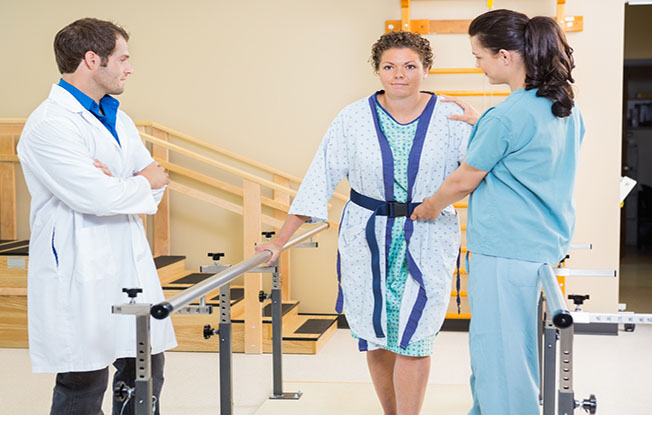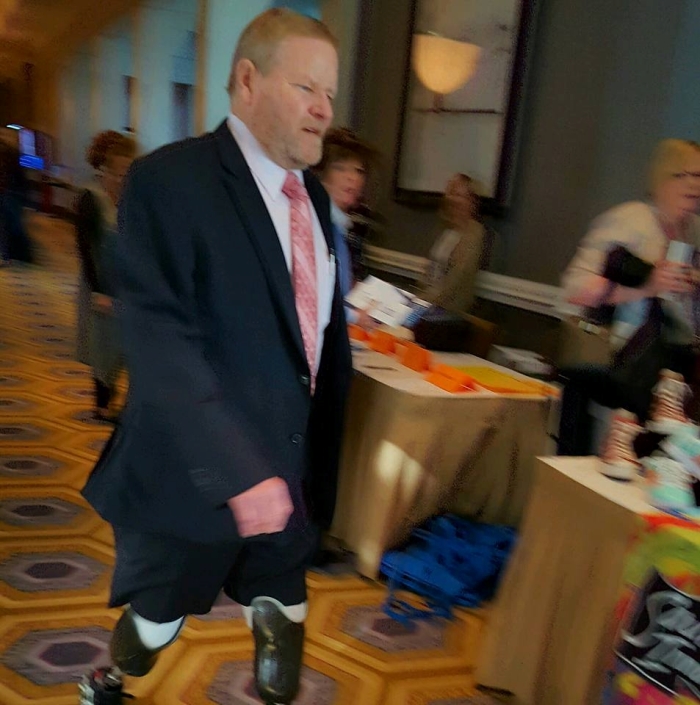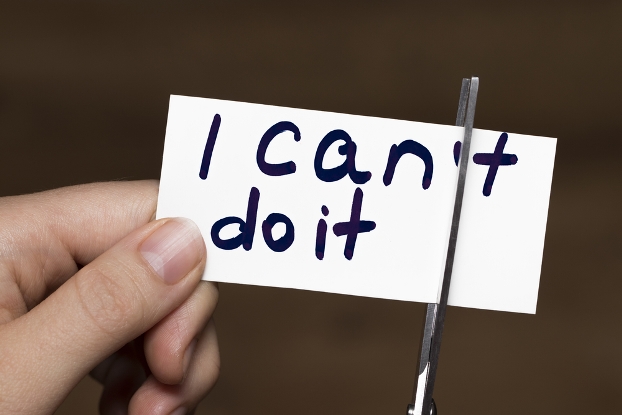Many stakeholders in the workers' compensation industry havebeen engaged in conversations regarding opportunities to improvethe workers' comp system, but the perspective of injured workershas been sorely lacking in these conversations.
|This perspective has been difficult to obtain because there areno respected “injured worker” advocacy groups such as there are inthe group health setting. Attorneys and unions are not the truevoice of the injured worker: They have their own sets ofpriorities.
|The voice of the injured worker is an important one. It willhelp us gain a deeper understanding of the challenges in theworkers' compensation setting as well as give us greater empathyfor what they are facing.
|At the 2016 Comp Laude Gala, the Alliance of Women in Workers'Compensation sponsored a session featuring injured workerstalking about their struggles. It was an extremely powerful andmoving experience that left few dry eyes in the packed room. Inthis article, we seek to convey the essence of that session. Ourgoal is for this information to be used to help us understand theobstacles faced by injured workers so that we can be betteradvocates for them and, ultimately, achieve better outcomes onclaims.
|Related: The impact on mental health and well-being inworkers' comp
|The participants
The participants included an injured worker in recovery from hisdependency on opioids, now taking his life back 14 years after hisinjury. Another, with two prosthetic legs, continued working andleaves a legacy for the workers' comp community. A thirdparticipant was a woman with incomplete quadriplegia, who started abusiness helping others with chronic pain.
|All three of these injured workers have unique personalitiesthat may have contributed to their successes. But the one thingthey have in common, which was a deciding factor for all, wassupport, positivity and encouragement from people around them —especially those in the workers' comp industry. The stories theyshared should send the message that by taking responsibility forour actions, words and decisions, we can truly make a differencefor injured workers as well as for our organizations.
|Related: Workplace injuries & illnesses in 2015[infographic]
||For some injured workers, life can become a downward spiralof more and more pain medication with little relief. (Photo:Shutterstock)
|Kenny
|
“I had never hurt my back in my life, but I twisted it liftingsomething.” That was in 2000, before his 40th birthday. By 2014,Kenny had undergone two surgeries, multiple implants, epidurals anda myelography — which he described as “the worst thing in my life”— and was prescribed a cocktail of various opioids. Eventually, hewas told by one medical professional that he would likely be deadin two years from all the medications he was taking.
|“Your mind just goes,” he said. “You're useless. Suicide — it'sright there.” Two case managers and several years later, thingswere no better. Though he wanted to work again, the back fusionsleft him unable to walk, and the meds left him in a zombie-likestate.
|“It was scary,” said Kenny's wife, Karen. “I lost my husband; myboys lost their dad.”
|Kenny and Karen's story might have continued that way forever,if not for the arrival of their third caseworker 12 years after theinitial injury. “It was like she flew in on angel wings,” saidKaren. “She took the time to get to know him. Nobody else did.”
|The caseworker sent Kenny to a Florida hospital for treatment.There, he received rehab, biofeedback and the care he truly neededto be able to function again. Six weeks later he was no longertaking the Hydromorphone, the Fentanyl, the OxyContin, thePercocet, or the Duragesic patches. Three years later, Kenny isstill off the medications, including aspirin. He goes to the gymdaily to walk, do light stretching and exercise. “I'd tell anyone,'Get off the drugs; that's 50% of your pain,'” he said. “Your bodywill help heal you.”
|Previously, one physician had told Kenny he wasn't going to getany better. The first caseworker was “distasteful,” he recalled,and he never even met the second one in person. The third caregiverwas the right person to help turn things around.
|“It just really matters what you say — as a doctor, nurse orcase manager. And that was the big difference for us,” Karen added.“She never said anything negative. She always said, 'we're going todo that,' 'we're going to get you to that,' and we believedit.”
|Related: Non-opioid treatment alternatives
|
Some patients need to relearn basic skills, like walking.(Photo: Shutterstock)
|Becky
It's been more than a decade since Becky was lying in a hospitalbed with a broken neck, two collapsed lungs, all of her ribs on oneside broken, and a broken clavicle. A work-related auto accidentrendered her “an incomplete quadriplegic.”
|“My spinal cord was damaged, but not severed,” she explained.Her left side has partial paralysis. Her right side looks normal,but she can't feel hot or cold, sharp or dull sensations.
|Becky had to learn how to walk again and to function with onehand. Then, two years later, she developed burning nerve pain fromthe neck down. “That was the darkest time for me,” she said. “Theytried all kinds of medications. I was depressed, I wasn't sleepingat night, I stopped exercising, and I stopped having any kind ofpositivity. It was a really, really dark time.”
|Becky was subsequently diagnosed with a syrinx — a fluid-filledcyst in her spinal cord. In her case, it is essentially inoperable.Becky reluctantly agreed to go to a functional-restoration programin California, although she wondered how that could alleviate herpain.
|“I discovered that pain is an experience, not a sensation. And Iget to decide what it means,” she explained. “And when the feargoes away, and the negativity goes away, the pain comes down. Andwhen my activity goes up, eventually I'm less sore and I'm better.And life could still be good.”
|When someone asked what she focuses on while feeling burningnerve pain from the neck down, she responded: “You focus on theneck up. There's always something we can focus on that is OK.” Sheadded, “If everybody's on the same page — the provider, casemanager, adjuster — even if it's just one person that will speaksome kind of positive into your experience, it makes a hugedifference.”
|Becky has an active life these days. She and her husband, Barry,have started a company to help people with long-term chronicpain.
|It is something with which she is intimately familiar. “I stillhave the syrinx. I still have burning nerve pain from my neck down,it just doesn't have me,” she said. “I don't take any meds. I livea very good, very functional life.”
|
Dwight Johnson on the move. (Photo: Soule Innovations,Facebook)
|Dwight
Despite losing both legs from two work-related incidents, DwightJohnson became a force within the workers' comp community. He wastired of people looking at his prosthetic legs and decided to givethem something special to see. He started creating outlandishlycolored hand-painted sneakers — first for himself, then for others.These gained notice when they were worn by the late David DePaolo,founder of WorkCompCentral, at numerousindustry events.
|Dwight's story began seven years ago, when he picked up a staphinfection while working in Hong Kong. By the time he returned toLos Angeles, his left leg was dead and had to be amputated. Hereturned to work with the one prosthetic leg, inspecting some ofthe world's tallest buildings.
|Three and-a-half years later, Dwight suffered another industrialaccident, leading to the loss of his other leg. A native of the DelMar, Calif.-area beach community, he was an avid surfer, andutilized prosthetic legs to surf. He also had special legs made forrunning and was doing stained glass artwork for restaurants in theSan Diego area.
|In addition to his hobbies, the father of seven opened SouleInnovations, a business that creates brightly colored sneakers forpeople. He and his wife Debbie also donated the shoes to otheramputees and war veterans.
|Tragically, Dwight passed away in March of this year fromheart-related issues, but his positivity and energy are notforgotten.
|The lessons? The stories are different. But themessages from these and other injured workers are the same:Positivity, peer support and advocacy are imperative torecovery.
|
Injured workers need positive attitudes from everyone aroundthem to help them heal. (Photo: Shutterstock)
|Positive attitude
“After an injury, the person dealing with us has to bepositive,” Dwight explained. “We're trying our best, but on theother end of the line, tell me everything's going to work; tell meyou care. It's so important.”
|The attitudes of those involved with an injured worker are vitalin determining the outcome. Karen can't forget the medical providerwho walked into the exam room, looked at Kenny's information andtold him, “You're as good as you're going to get.” On the way homefrom the appointment, Kenny was crying in the car and asking, “Thisis it?” Those and other negative conversations kept Kenny in adisability mindset until his third caseworker arrived on thescene.
|Becky related her experience when she was first in the hospital.“As soon as they took the ventilator tube out of me I asked,'What's the prognosis?' [The doctor] just looked at me and said,'You'll never be normal.' I cried after that. Couldn't move,couldn't scratch my nose but I didn't like that answer,” she said.“I asked another doctor the next day. He smiled and said, 'You'regoing to walk again.'”
|That type of positive reinforcement made a difference in Becky'sattitude and ultimately, her outcome. Much of Becky and Barry'swork with chronic pain patients involves reframing the message.
|Nevertheless, the message must be truthful in addition to beingpositive. “One thing that used to really get to me is if someonesaid, 'We're going to bring you back to normal,'” Dwight said. “IfI'm going to be normal, we're going to cut everybody's legs off andthen we'll be normal. Normal for me would be impossible. It has tobe positive. We all have to work on ourselves.”
|
Patients need advocates so they don't feel alone in theirstruggle. (Photo: Shuttertock)
|Advocacy
Peer advocacy is also crucial to a positive outcome. Often theinjured worker's only support is his family, and that can bevolatile.
|“It's a powerful journey to be a spouse of an injured worker,”explained Barry. Fear creeps in, he said, which can impederecovery. “It's easy to find yourself defaulting to that workers'comp check that's in the mail. It's almost a feeling like, 'you'vegot to stay injured, you've got to stay dependent.'”
|For the employees and their families, showing support and caringcan make the difference between an injured worker staying dependenton the system or recovering.
|“It begins with positivity,” Barry said. “I coach family membersof people going through pain, and we talk about grieving that loss.At the same time, grief is also acceptance of what you've lost andcelebrating what you have. We spend a lot of time on that.”
|Becky empathizes with her clients who are going through thepain. “We specialize in the difficult cases,” she said. “We want togive them hope, support and all they need to be self-managersinstead of passive patients.”
|Hearing and believing what the injured worker says is a crucialpart of advocacy. In Becky's case, her diagnosis of “incompletequadriplegia” may have expedited the care she received. But a caselike Kenny's, with a questionable diagnosis, is more vague andcomplex. There can be a stigma attached that can leave the injuredworker feeling alone and forgotten.
|“If somebody's on drugs for two or three years and nothing ishappening, you've got to stop it then,” he said. “Thirteen or 14years is terrible. You go to these doctors and say, 'Yes, my back'skilling me.' They write you a prescription and that's it. It'shard.”
|Kenny spoke of the family-like support he received at the rehabfacility as key in his recovery. For the 12 years before, he hadonly his wife.
|“If somebody is alone and disabled, I don't even know how theycope,” Kenny said. “I was in such a stuporish state that, if Karenwasn't there or later on, when [the case worker] came into ourlives, if she wasn't there, I'd probably be dead right now.”
|Dwight likewise found good support from his provider. “My doctorgave me two options: 'Put you in a wheelchair and give you enoughdrugs, or get up off your ass and do something.'” He chose thelatter.
|Kimberly George is the senior vice president, seniorhealthcare advisor at Sedgwick. She can be reachedat [email protected].Mark Walls is the vice president, communications andstrategic analysis, at Safety National. He can be reachedat [email protected].
Want to continue reading?
Become a Free PropertyCasualty360 Digital Reader
Your access to unlimited PropertyCasualty360 content isn’t changing.
Once you are an ALM digital member, you’ll receive:
- All PropertyCasualty360.com news coverage, best practices, and in-depth analysis.
- Educational webcasts, resources from industry leaders, and informative newsletters.
- Other award-winning websites including BenefitsPRO.com and ThinkAdvisor.com.
Already have an account? Sign In
© 2024 ALM Global, LLC, All Rights Reserved. Request academic re-use from www.copyright.com. All other uses, submit a request to [email protected]. For more information visit Asset & Logo Licensing.









